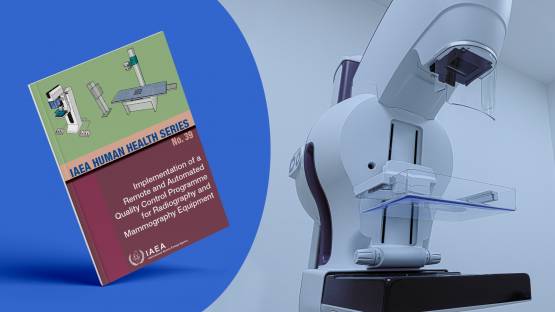Regular quality control testing of medical radiological equipment improves clinical image quality and reduces radiation exposure of patients. Radiography and mammography machines, for example, may produce inaccurate images if not calibrated after a long series of exposures. Therefore frequent equipment testing can detect unwanted fluctuations in image quality and radiation dose.
Most existing efforts as part of a quality assurance programme, however, involve complicated and expensive test objects and infrastructures. There are also many different quality control test objects – known as phantoms – needed to test the numerous technical parameters of each X ray modality, be it radiography, fluoroscopy, mammography, computed tomography or others.
To facilitate more frequent testing of X ray equipment, the IAEA has released a new methodology offering remote and automated solutions for quality control, using simple, inexpensive test objects and a free software programme.
“Digital technology systems are rapidly becoming the standard in medical imaging,” said Maria-Ester Brandan, Professor of Physics at the Physics Institute of UNAM, the National Autonomous University of Mexico. “However, many radiological departments are not equipped with the required human and infrastructure resources to evaluate and assure that images have the quality required for their clinical use. Remote quality control appears an efficient alternative solution.”
Remote quality control tools are used by medical physicists to facilitate daily or weekly testing to ensure the consistency of performance in-between the comprehensive annual evaluations of the equipment. Automated quality control tools, such as the one developed by the IAEA, also allow for both simple and advanced analysis of image quality parameters.
The use of phantoms made from locally purchased and manufactured materials as suggested in the IAEA methodology, rather than costly commercial phantoms enables quality control tests to be performed on a daily or weekly basis using a detectability index (d′). The accompanying software allows for complete and automated evaluation of the principal performance characteristics of the imaging chain.
The IAEA methodology provides a standardized way for testing the performance of X ray radiography and mammography machines in daily clinical practice, including sites where travel is difficult. The phantoms can be easily fabricated using material that is readily available. The software is robust and reproducible, and the implemented metrics provide the latest objective measures of image quality, making them also a valuable adjunct to traditional quality control approaches using localized simple measurements made manually on the image. Initial pilot results provided invaluable findings that have recently been published in the Journal of Applied Clinical Medical Physics.
"This is an excellent example of how technology has evolved the work of a medical physicist,” said Harry Delis, diagnostic radiology medical physicist at the University of Patras, Greece. “Adding new sophisticated and user independent tools to their toolbox will facilitate immensely obtaining consistent and high quality imaging in the everyday clinical routine, even in remote rural areas.”
IAEA experts envision that much benefit can be derived not only from the use of the remote and automated technology, but from collaboration between health facilities using the IAEA methodology. “Such collaboration can be as simple as sharing trouble-shooting techniques or helping with the development of clinical imaging protocols,” said Olivera Ciraj Bjelac, imaging medical physicist at the IAEA Division of Human Health. “Future steps could include the establishment of user groups, conduct of on-line and face-to-face meetings and exchange of ideas and methods along with discussion of problems and solutions.”
Further information on the new IAEA remote/automated quality control methodology is available at the IAEA Human Health Campus.





